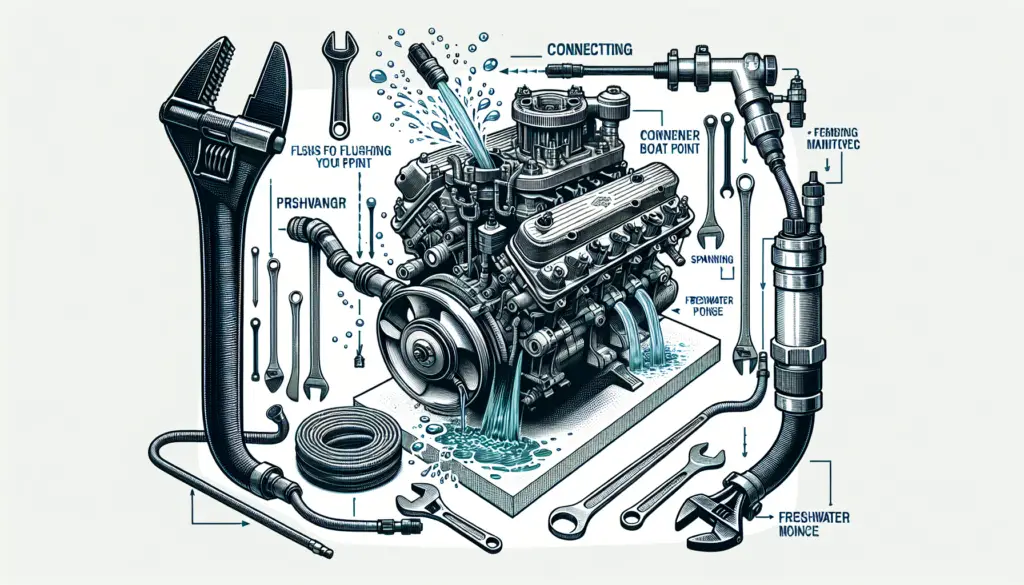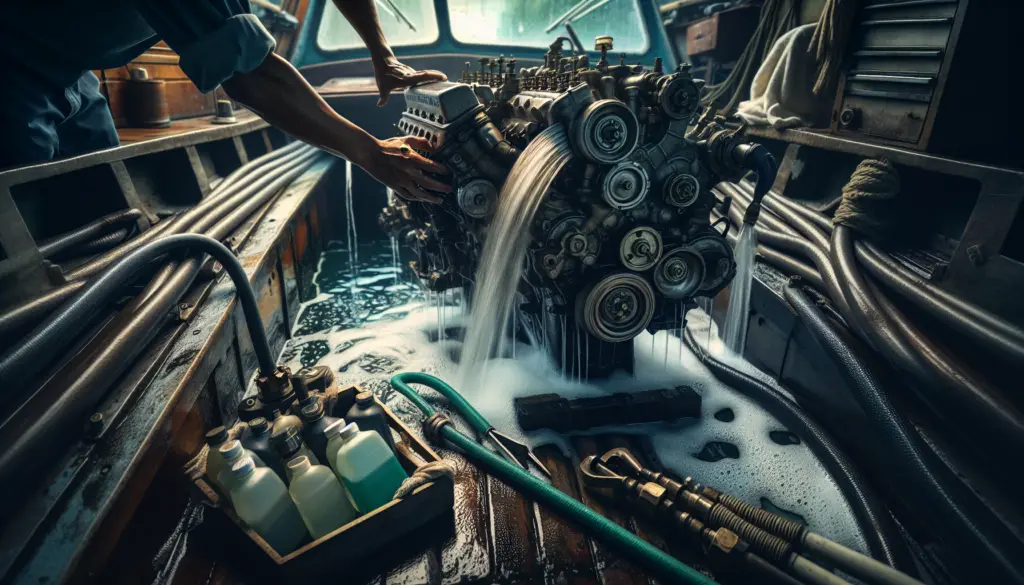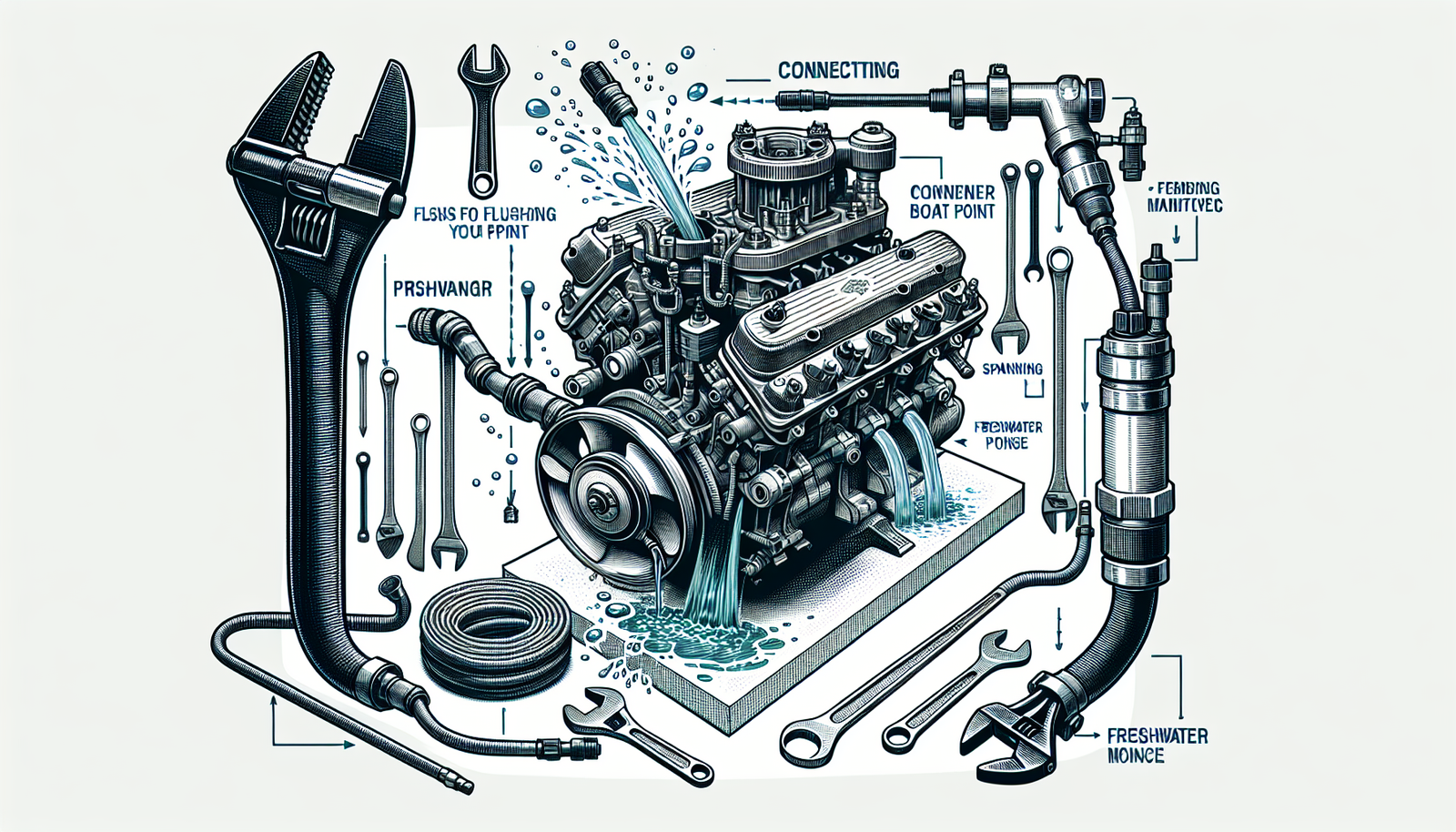If you’re a boat owner, there’s one maintenance task that should always be on your radar – flushing your boat engine. Going on a leisure cruise or an adventurous fishing trip can be great, but it’s paramount that you take care of your water ride’s heart – the engine. Neglect it, and you’ll find yourself stranded mid-sea with a jammed motor. “Expert Tips for Proper Boat Engine Flushing” is a comprehensive guide to ensure you don’t end up in such a catastrophe. It’s filled with invaluable advice from experts, laying out step-by-step instructions and clarifying why certain procedures are necessary for keeping your boat’s engine performance top-notch.

Understanding the Importance of Flushing Your Boat Engine
Well, hey there! So, you’ve made the investment and become the proud owner of a boat, right? Good for you! Now, covering the full specter of boat care entails not only cleaning the hull, trying to dodge bird droppings, or using the boat frequently to prevent ‘sea rot’. It also includes one of the most crucial parts of boat maintenance – flushing your boat engine.
Think of your boat’s engine as the boat’s heart. Now, just like you wouldn’t want your heart clogged with unhealthful deposits, you certainly wouldn’t want that for your boat engine either – which is where flushing comes into play.
The role of regular engine flushing in maintaining boat health
Why is regularly flushing your boat engine such a big deal? I’m glad you asked! Flushing your boat engine helps extend its longevity significantly. The process removes harmful debris, sediment, and corrosive substances like salt that can accumulate over time, preventing wear and tear on the engine. Plus, it keeps the engine’s cooling system running efficiently by getting rid of any clogs or blockages that could otherwise impact its performance.
Risks associated with failure to properly flush a boat engine
Not properly flushing your boat engine can cause serious issues. The debris and sediment I mentioned before can corrode internal components of the engine and obstruct the cooling system, causing overheating. Engine failure, higher repair costs, or even total engine replacement can occur due to neglect – a scenario nobody wants to end up in!
The impact of salt and freshwater on your boat’s engine
Salt (found in seawater) is surprisingly corrosive to your boat’s engine and its parts, causing corrosion and rust. On the other hand, freshwater has minerals and sediment that can accumulate and cause blockages. Hence, regardless of the type of water you sail in, flushing your engine is an absolute necessity.
Identifying the Appropriate Flushing Method
Rather than falling into the trap of thinking “one size fits all,” it’s essential to understand that the content of your boat, particularly the type and model of your engine, largely determines the ideal flushing method.
Understanding different types of flushing: on-water vs off-water flushing
To boil it down to the basics, the whole flushing process can be done either in the water (on-water) or off the water. On-water flushing generally works for newer models with built-in flushing systems, while off-water flushing often requires the boat to be removed from the water and uses devices like flushing muffs.
Selecting an appropriate flushing method based on boat engine type and model
Each boat engine type may need a particular flushing approach. For instance, outboard engines often use flushing ports or muffs, while inboard engines and sterndrives may require different procedures. Your engine model might also factor into the equation, with newer ones often designed with more straightforward, user-friendly flushing systems.
The role of boat manufacturer guidelines in choosing a flushing method
If in doubt, always refer to your boat or engine manufacturer’s guidelines. Manufacturers know their product best and typically offer recommendations on the most effective and safe flushing techniques for their engines. It’s also a good way to avoid invalidating any warranty by using an inappropriate flushing method.
Step-by-Step Guide on Using a Flushing Port
Now, let’s get down to the nitty-gritty. If your engine comes with a flushing port, congratulations – you’ve got a somewhat more straightforward process ahead.
Identifying and locating the flushing port on your boat’s engine
Your first step is finding this flushing port. It’s typically a hose connection point on the side of your engine. If you’re having difficulty locating it, refer to your boat’s manual or get in touch with the manufacturer.
The importance of connecting the water supply before starting the engine
Before sparking that engine into life, connect a garden hose to the port, ensuring a steady water supply. Remember, running your engine without water can cause severe damage rather quickly.
Proper procedure for flushing through the engine’s flushing port
Turn on the hose, secure a consistent water flow, and then only start the engine. Allow it to run in idle for about 10 to 15 minutes, letting the water work its magic. After that, you can shut off the engine, stop the water supply, and disconnect the hose.

Step-by-Step Guide on Using a Flushing Muff
When no flushing port is in sight or in models for which muffs are simply more effective, you can turn to flushing muffs. Let’s dive into how to work with these.
Understanding when to use a flushing muff instead of a port
Flushing muffs are often used with older or outboard engines and generally require the boat to be out of the water.
Safely connecting the flushing muff to the water intake
The muff connects to your garden hose and then fits over the engine’s water intakes, typically located on the lower unit of the engine.
Effective flushing techniques using flushing muff
As with the flushing port, steady water pressure is first ensured before starting the engine. The engine is then allowed to run at idle speed, with fresh water circulating through the muffs and into the engine’s cooling passages.
Guidelines for Flushing an Outboard Engine
Outboard engines, those located outside the hull, require some specific attention.
Specifics of maintaining and flushing outboard boat engines
Outboard engines are typically easier to flush, often designed with built-in flushing ports or being compatible with flushing muffs, and generally don’t require the boat to be out of the water.
Common mistakes to avoid when flushing an outboard engine
Pay special care not to start the engine before establishing a steady water supply. Also, avoid revving the engine during flushing, as it should ideally be left at idle.
Expert tips for outboard engine flushing
If using muffs, always ensure they are covering the intake grills completely before starting the engine. Also, visually check that water is being expelled from the “pee hole” or the tell-tale output to ensure water is running through the system.
Guidelines for Flushing an Inboard Engine
Inboard engines, those housed inside the boat hull, call for a slightly different approach.
Important considerations for maintaining and flushing inboard boat engines
Due to their placement, inboard engines often employ engine-driven raw water pumps. They are cooled by means of raw water drawn from under the hull and need to be flushed carefully to avoid pump damage.
Potential challenges and solutions when flushing an inboard engine
Due to the water pressure being generated by the movement of water into and through the engine, simply attaching a hose and starting the engine is insufficient and possibly damaging. Specialized flushing systems designed for inboard engines, or motor flushers that fit onto the raw water pump intake, can be used instead.
Expert tips for inboard engine flushing
Again, a proper water supply should be set up before starting the engine. If using a flushing system, run the engine at idle speed for the duration of the flush.
Understanding Potential Flushing Issues and Solutions
A bit like a boat ride itself, engine flushing can sometimes hit choppy waters.
Identifying common problems that might occur during engine flushing
Common issues include insufficient water supply, leading to overheating, and incomplete muff placement causing water to not flow correctly.
Troubleshooting tips for when things go wrong
In these cases, stop the engine immediately once an issue is noticed. Check your water connection, reposition the muffs if necessary, or consult your manufacturer’s guidelines.
Precautions to prevent serious flushing failures
Ensuring you follow the right procedure for your engine, regular upkeep, and properly storing your boat can help prevent serious flushing failures and resultant engine damage.
Safeguarding Your Boat’s Engine Post-Flushing
Just like you wouldn’t leave the dishes to dry haphazardly post-wash, your boat engine needs some careful handling after flushing, too.
Effective engine drying techniques post-flushing
Ideally, have the engine run for a few extra minutes post-flush to help dry it out. Additionally, the engine compartment should be left open to air-dry fully.
Proper post-flush engine storing methods
If storing your boat post-flushing, ensure the engine is thoroughly dry to prevent rusting and corrosion. Lifting outboard engines helps drain any remaining water, while engine covers can offer added protection during storage.
The importance of regular service and maintenance beyond flushing
Treat flushing as part of your comprehensive engine maintenance activity. Regularly check the engine oil, keep an eye on moving parts, and schedule services as suggested by your manufacturer.
Flushing Frequency Recommendations
Now, after all this flushing talk, you’re probably wondering how often to do it, right?
Determining a proper engine flushing schedule
The frequency of flushes depends on usage and the water type. After every outing is best, particularly if you’re sailing in saltwater.
Factors that influence how often boat engines should be flushed
Usage frequency, time in water – both salt and fresh – and engine type and model are all key in considering flushing frequency.
Balancing engine flushing frequency with other maintenance tasks
While flushing is vital, remember to balance it with other maintenance tasks like oil changes and tune-ups to keep that boat engine purring.
Top Products for Effective Engine Flushing
To wrap things up, let’s quickly chat on some products that can make your boat engine flushing gig a whole lot easier.
Review of top-rated flushing ports and muffs
Various brands offer high-quality flushing ports and muffs with features like easy installation, anti-corrosive materials, and efficient design. The choice depends largely on your boat engine’s requirements.
Recommended engine flushing tools and supplies
Other than ports and muffs, marine antifreeze can be used during winterization flushing, while handheld pump systems might come in handy for inboard engines.
Pros and cons of using specific engine flushing products and brands
Ensure any product you choose is compatible with your engine. While some brands might offer faster flushing, some might be more durable.
That’s about it! I hope this article has been helpful, making the whole flushing process seem less daunting, and more importantly, underscoring the importance it holds in maintaining your boat’s overall health. Now, all that’s left to do is grab that hose, get to flushing, and then – enjoy the open waters!

